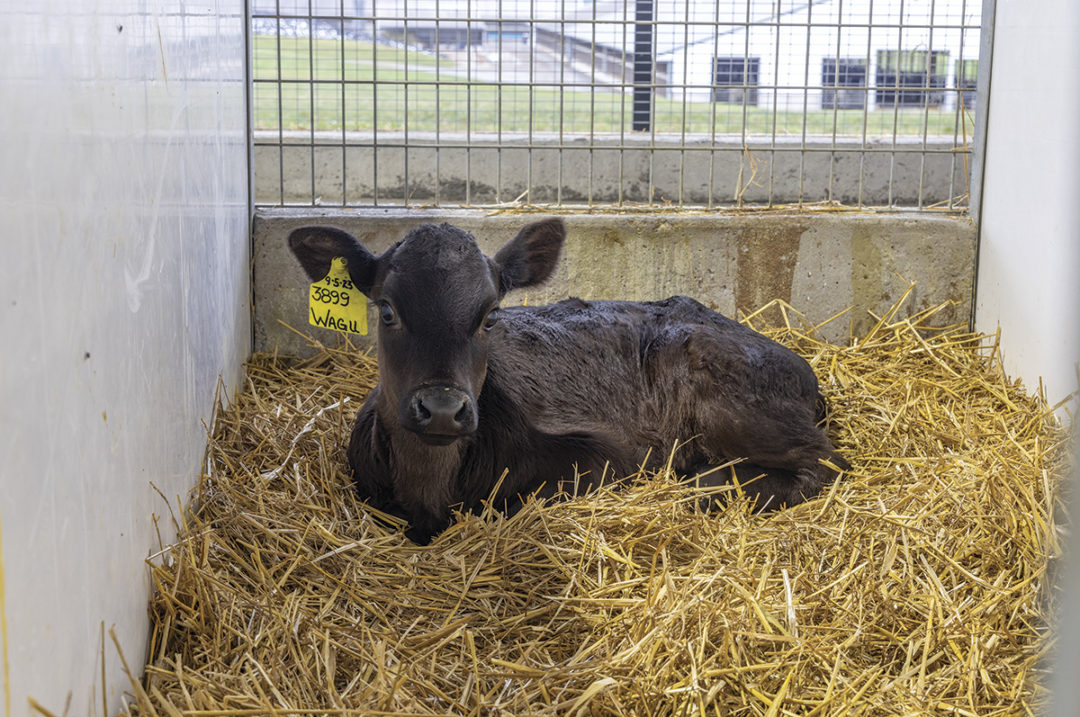As beef-on-dairy breeding continues to grow its presence and financial value on dairy farms across the U.S., special considerations are warranted for maximizing the unique potential that these calves have to offer – as well as averting the unique challenges that may present themselves along the way.
"The pre-weaning phase in all calves in general sets the tone for the rest of their productive life,” said Iowa State University master's candidate Taylor Klipp in a webinar presented by I-29 Moo University on March 5. Klipp presented her research on the importance of starch content in calf starter on weight gain in pre-weaned beef-on-dairy calves. A Kansas native finishing her master’s degree in animal science under Dr. Gail Carpenter, Klipp grew up raising calves on her family’s dairy farm and has held multiple internships in calf barns across the Midwest. In addition, she interned at an Angus and SimAngus seedstock ranch in Kansas and is involved on her fiancé’s cow-calf operation in Nebraska.
Proper rumen development key to avoiding discounts
Starter starch content is particularly important in the ration of baby calves because as the grain enters the rumen, it is converted into butyrate, which stimulates the growth and development of epithelial cells within the rumen. Corn and soybeans are slowly fermented, while wheat and barley are rapidly fermented. However, high-concentrate diets fed over these calves’ productive lives can increase the likelihood of developing ruminal acidosis and subsequent liver abscesses that may lead to packer discounts on finished carcasses.
Klipp explained that, compared to their straight-beef counterparts, beef-on-dairy calves are weaned early from a liquid milk diet and need a functional rumen to maintain growth and overall health. Easily digestible feeds, like calf starter, support calves’ growth curve and development as they transition from a liquid diet to full rumination.
“It is important for them to have their rumen developed completely by the time they’re weaned,” Klipp said. “The starter is also there to support optimal bodyweight gain and frame growth.”
Studying rumen development
Klipp’s research examined 120 calves divided into three groups of 40, the first group beginning in November 2022 and ending in January 2023, the second group starting in February and ending at the beginning of May 2023 and the third group going from July to October 2023. The average temperature for each group was 28.19ºF, 48.32ºF and 66.7ºF, respectively.
Calves were sourced from Iowa State as well as a couple of dairy farms local to the area. From birth, they were raised in the research barn, which was a hoop barn converted from loose housing for weaned calves to individual pens with adjustable curtains and stir fans.
For the first week, calves were fed 3-quart bottles of milk replacer twice a day. They were offered 4-quart bottles twice a day from week two through week six before dropping down to 4 quarts once a day at week seven, and they were totally weaned from milk by day 56. Grain was offered to the calves from day one. In addition, calves were castrated around weeks four to five and vaccinated around weeks five to six.
“[Step-down weaning] kind of allowed the calves to adjust so it wasn’t a cold turkey weaning. The calves were able to adjust to eating more grain and less milk,” Klipp said.
Under Klipp’s direction, weaned calves stayed on that whole grain diet for one week as an acclimation week, and then at the end of that acclimation week, they were transported to the next step of the study at Iowa State’s Beef Nutrition Farm (BNF).
The calves were divided into two groups upon their arrival at the research barn, either receiving 26% high-starch or 15% low-starch diets. The high-starch group was fed 33.9% fine ground corn and 23% dehulled soymeal compared to the low-starch group getting 11.4% and 29.9%, respectively.
On the flip side, the low-starch group was fed higher amounts of fiber in the form of wheat middlings (35.6% compared to 21.1%) and cottonseed hulls (10% compared to 5%) to make up for the lack of energy compared to the high-starch group.
The average weight for the high-starch group at birth was 92.3 pounds, and the average weight for the low-starch group was 92.9 pounds. Bodyweights were collected initially and twice a week, and various frame growth measurements such as wither height, hip height, length (taken from the point of shoulder to the pin bone), heart girth and hip width were taken at weaning.
Observations
Klipp presented a chart detailing grain intake over time from days one to 56.
“Around day 22, the high [starch] calves started to pull away from the low [starch] calves on [starter] intake,” Klipp said. Klipp observed that some of the calves on the high-starch diets would eat their straw bedding, perhaps as a means to alleviate stomachaches caused by minor acidosis, and she wondered if that could be a precursor for developing ruminal acidosis later in life.
Body measurements were taken on day 63 as calves were leaving for BNF. The most statistically significant differences (p-value > 0.05) between the high-starch and low-starch groups were found in heart girth at 43.1 inches versus 42.4 inches and length at 38.4 inches versus 33 inches. All other measurements showed no statistically significant differences.
At the end of the webinar, Klipp was asked if the calves’ milk intake – especially compared to most of the dairy industry feeding lower milk volumes – had an effect on the calves’ starter intake.
“There is always that potential of how milk replacer intake affects grain intake, so that’s something we have to consider when we are looking at grain intake and comparing [it] to other studies as well,” Klipp said.
Klipp was also asked about water intake. She said that while water intake wasn’t measured, she didn’t notice a difference between the two groups, but she reiterated that starter intake drives water intake and vice versa.
Regarding cost of gain between the two groups, Klipp noted that the low-starch diet was more expensive than the high-starch diet.
“In the big scheme of things, what does all this mean?” Klipp asked. “The high-starch calves ate more but did not significantly gain more.”
To maximize growth and rate of gain, Klipp reiterated the importance of colostrum volume and quality, starter availability, rumen pH as calves transition from milk-fed babies to ruminants, as well as ventilation to lessen any seasonal effects on air quality across all types of calf housing.
“This is a good basis for future projects. We can definitely tell that source dairies value their beef-on-dairy calves. We can see that through feeding 4 liters of quality colostrum,” Klipp said. “That, in and of itself, means to me that producers do value these calves.”








